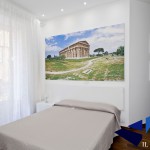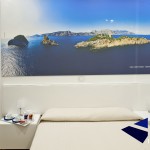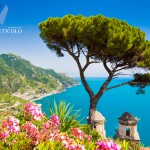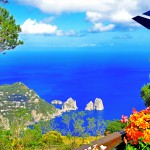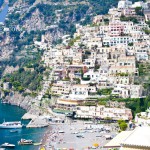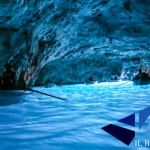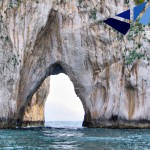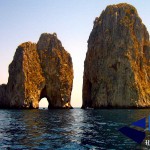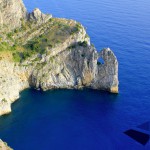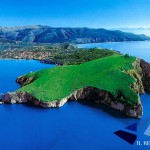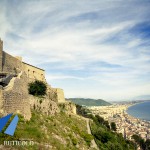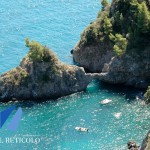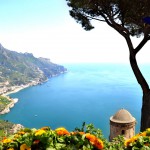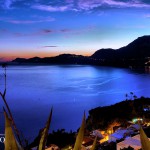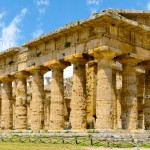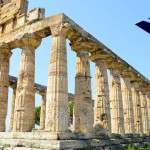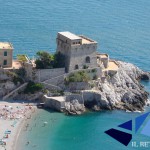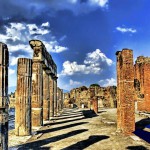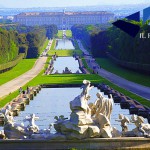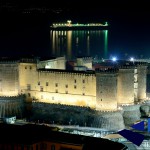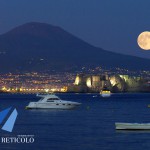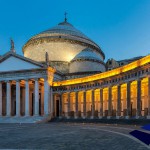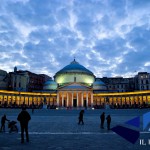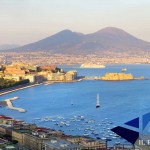We are a few steps from the main centers of interest and attraction: from the Amalfitana Coast (Called the ” Divine “) to the Cilentana Coast, the Ruins of Pompeii, Caserta Royal Palace, the city of Naples, the Temples of Paestum and the Certosa of Padula. These destinations are easily accessible by sea and rail links of our city of Salerno.
Amalfitana Coast
Forty kilometers of coastline divided Salerno and Positano, and once here you will do ten more kilometres to reach Sorrento.Step by step, here are all the places that not to be missed in your tour on the Coast: Vietri sul Mare – Cetara – Erchie – Maiori -Minori – Atrani – Amalfi – Conca dei Marini – Furore – Ravello – Praiano – Positano .
Vietri sul Mare (from Salerno: 3 Km)
Staying at B&B you have the Amalfitana coast at only three kilometers (a few minutes by train, bus or taxi), exactly those that separate us from the picturesque seaside town of Vietri sul Mare. The dome of St. John the Baptist Church, with its beautiful majolica, is the first sign of welcome with which the “divine coast” greets the visitor at the exit of the highway. Vietri is known around the world for ceramic art work: it pays to browse through the shops to buy one of the precious artifacts on display, or simply to choose an original object to bring friends to return from the trip.
Cetara (from Salerno: 7 Km)
Few bends after Vietri sul Mare and you arrive to Cetara, quiet fishing village which still maintains the charm of the old days. Here the seafaring and fishing is revived every year, in August, with the Tuna Festival, which has always preferred prey of cetaresi experienced fishermen. There is a very popular beach down to the country, but stopping along the coastal road you can access (going down a lot of steps) to a beautiful cove with a free beach or equipped beach. From Salerno it takes about ten minutes to reach Cetara.
Erchie (from Salerno: 8 Km)
The Erchie beach is bigger than that of Cetara and the sea is clean the same. The village is collected and does not offer many things to see (except a nice church), but it is the ideal place to spend a day at the seaside take on the fatigue of long stairs.
Maiori (from Salerno: 18 Km)
At Maiori the context will be lively thanks to the many young people who flock to the long sand and shingle beach and find themselves, until late at night, in the cafes and restaurants along the waterfront. The country still offers many things to visit, including the Castle of San Nicola de Thoro-Plano, the Collegiate Church of Santa Maria a Mare (XIII century) and the Abbey of Santa Maria de Olearia. An event takes place in a particular flavor easter period (Pentecoste Monday) when a large number of devotees flock on Mount Mirteto, near church of Avvocata, to pay tribute with the typical ritual of tammurriata their homage to the Madonna.
Minori (from Salerno: 20 Km)
The “little sister” of Maiori has a personality and acharm all its own, which is fully manifested in the atmosphere collection of the village and in the many monuments and churches on this piece of land lapped by the sea. In addition to the Basilica of Santa Trofimena, worth visiting the Roman Maritime Villa (which houses precious artifacts and mosaics of age), the Annunciation Campanile and the Confraternity of the SS. Sacrament.
Amalfi (from Salerno: 23 Km)
Amalfi is a place that will leave you breathless from the first sight: kissed by the sun for most of the year, this small town framed by mountains softly slopes towards the blue sea. To look at her so, with this air so expanse, it seems almost impossible to think that a thousand years before it was such a busy dominate maritime trade in the Mediterranean. Traces of this glorious past can be found in the Ancient Arsenals of the Amalfi Republic, where the galleys were built, and in the Maritime Code of Amalfi (known as “Tabula de Amalpha”) a copy of which, written in the ‘400, is preserved in the Civico Museum. Walking through the streets of the Old City you will find the impressive Cathedral of Sant ‘Andrea, in Arab-Norman style, with its famous staircase dominates the central square of the village. Crossing the magnificent Byzantine door, cast in Constantinople in 1066, the three-nave interior is striking for the beauty of the pillars covered with polychrome marble, the coffered ceiling in pure gold, silver and precious paintings. From the Cathedral we pass the Paradise Cloister, a small jewel in which relives the magic of the Middle Eastern palaces, and from this you enter the Diocesan Museum of the Basilica of the Crucifix which liturgical vestments, sculptures, mosaics and other treasures. The Race of the Ancient Maritime Republics is a sporting event of historical commemoration, which was established in 1955 with the aim to evoke the companies and the rivalry of the best known Italian maritime republics: that of Amalfi, Genoa, Pisa and Venice, during which they challenge each of their four crews remieri representatives of each of the republics. This event, held under the high patronage of the President of the Italian Republic, is held annually on a day between the end of May and the beginning of July, and is hosted in rotation among these cities. The race is preceded by a historical procession, during which parade through the streets of the host city a few figures that take on the role of ancient characters that characterized each republic.
Atrani (from Salerno: 24 Km)
Atrani is the ideal place to stop for dinner after a day at the seaside and sample delicious fish and seafood dishes.
Ravello (from Salerno: 29 Km) Built in the sixth century, Ravello is situated in one of the widest points of the gulf. Immersed in its architectural beauty and its charming landscape, Ravello is regarded as the most precious gem of the Amalfitana peninsula, which is reached through one of the streets of the most striking beauty. For this reason it has been a favorite destination for travelers, intellectuals, artists, musicians, such as Boccaccio, Wagner and many others, here they drew inspiration for their works. The town still retains its medieval appearance: winding streets, villas, churches with wonderful mosaics testify to the Byzantine and Arabian influence on the southern Romanesque. To visit Villa Rufolo dates back to the XIII-XIV centuries and belonged to the Rufolo family, then to the Confalone, the Muscettola, the DAffitto, and finally, in the mid-nineteenth century, the Scot Francis Neville Reid. The building, with three floors in Arabian-style, hosted important figures such as Pope Adrian IV and King Robert of Anjou. In the beautiful exotic garden of Villa Rufolo, Wagner found himself the ideal of Klingsor Parsifal garden; in its terrace overlooking the sea is now the famous Wagnerian Festival. Villa Cimbrone can be definite the visionary creation of an English lord. Its history is controversial, but without any doubt it is the fascinating result. The Villa Cimbrone site, as well as its name, is ancient: it was a large landholdings of the noble family Acconciagioco, on which stood a vast rustic farmhouse. The lush garden of the villa, with its scattered statues, temples, inscriptions, fountains, natural caves and crevices created on purpose, culminating in the spectacular viewpoint of Infinity, from which the view extends and expands to capture the view that Gore Vidal called “the most beautiful in the world”. Festival of Ravello and its villas are the backdrop for this musical festival, rich in classical music and jazz concerts. The inspiration that Wagner found here for his masterpiece Parsifal, has meant that this great artist is often celebrated during the concert season and has made Ravello famous worldwide as the “city of music.”
Conca dei Marini (from Salerno: 30 Km)
Going to Positano you meet Conca dei Marini, named so for the characteristic morphological shape of the place, is a picturesque fishing village perched on a rocky ridge. Here the sea is clear and bathing is an experience you will not forget.
Furore (from Salerno: 33 Km)
Immediately after here is the tiny Furore and its fjord, a large opening in the rock where the sea creeps and foams.
Praiano (from Salerno: 35 Km)
The beach of Marina of Praiano is an oasis of tranquility and beauty between two imposing rock faces. It can be reached easily by car coming down the road (there are good parking), or taking a bus or directly by boat from Amalfi. Also in Praiano it is the Cala della Gavitella, which holds a special primacy being the only place in coastal, where the sun slips behind the mountains before sunset: thanks to its exposure to the west, with views of Capri, Positano and the island of Li Galli, on this beach you can sunbathe until late.
POSITANO (from Salerno: 60 Km)
Thanks to the mild climate and the beauty of the landscape, Positano has been a resort since the days of the Roman Empire, as attested by the discovery of a villa and more discoveries dating back to 2004. Typical of the many stairways from the country that come down to the beach. The main beaches are the Great and the Fornillo beach, both within walking distance; the others are La Porta, Arienzo and San Pietro Laureano, all accessible mainly by boat.Pearl of the Amalfi Coast, Positano looks like a group of pastel colored houses clinging to the steep wall of the Lattari Mountains, which are reflected in the clear sea, surrounded by the intense aroma of lemon groves and by the bright and vivid colors of bougainvillea. Next, a maze of alleys and steps with small shops displaying the typical local handicrafts, which together with the undisputed scenery, helped make Positano and the Amalfi Coast famous all over the world. We refer to the fresh linen dresses in “Positano fashion style”, with leather sandals, the colorful ceramics and the limoncello.
Paestum (from Salerno: 40 Km)
Paestum, is easily reached by car from Salerno, just take the motorway A3 Salerno-Reggio Calabria highway, exit at Battipaglia, take the highway 18 and exit at the height of Capaccio Scalo; also numerous trains direct to Reggio Calabria continue to the railway stations of Capaccio and Paestum, in about half an hour. Around 600 BC the Sybaris Greek colonies gave birth to the south of the mouth of the Sele, the city of Poseidonia. The Paestum area touches the most beautiful stretches of the Tyrrhenian coast. The sea, the green and fascinating traditions of these places are the ideal destinations for excursions. At Paestum the myth and the legend coexist in an indissoluble union. It is to visit the whole archaeological area, starting from the sanctuary of Hera, one of the most famous of Magna Grecia; the Basilica, the largest and oldest of the three temples, the temple of Ceres, the temple of Neptune, the Amphitheatre and the Forum. The majestic Doric temples, illuminated by sunlight and the long coastal strip, brushed by a sparkling sea, make Paestum a charming place to spend their holidays. On the banks of Paestum a wide beach of fine sand, intersected by streams, outlines a scene characterized by a clear beach that stretches for about 14 Km. In the evening there erupts a unique view of spectacular sunsets on a iridescent colors horizon; background of this wonderful show the untainted beauty of Mediterranean vegetation at the edge of a thick pine forest. An environment alive with colors and scents, lights and shadows, where the viewer’s sensitive soul will find moments of intense fascination and wondrous enchantment. Considered World Heritage by UNESCO, Paestum remains for art, nature, the flavors and the events that characterize it, one of the most beautiful cities of Ancient Greece to visit and discover. Palinuro is one of the main tourist resorts of Campania. Its unspoiled coastline offers visitors beautiful stretches of beach and many small bays , hidden coves and sea caves . Just the beautiful sea caves represent a major attraction for the many tourists who come to visit them every summer . The Blue Cave owes its name to the plays of light created by a conduit to 20 meters of depth that allows the penetration of sunlight . The Silver Cave must , however , his name to the silvery reflection off the limestone deposited on the bottom, while the Blood Cave got its name in small red algae . The cave of the monks shows the many visitors of the limestone formations that take the form of monks in prayer . Memorable visit Natural Arch , a huge arch of rock that juts out into the sea , and the small bay behind named bay of Infreschi.
La Certosa di Padula
It is one of the most important and largest monastic complexes in Europe, declared by UNESCO World Heritage Site. The birth of Padula is in the IX-X century when, cease the Saracen raids, the people who had taken refuge inheights, preferred to settle on the hill, near the consular road, where it still stands the town. The founding site of the Charterhouse helped the Basilian monks, as evidenced by the Church of San Nicola to Women and the ruins of St. Nicholas Monastery in Torone.
NAPOLI
Piazza del Plebiscito: Symbol of the city, the square is more representative of Naples, but also the largest and for this seat, always, of festivals, events and celebrations of all kinds.
Piazza Trieste e Trento:The heart of Naples neoclassical and unification is adjacent to the Piazza del Plebiscito and surrounded by monuments and buildings full of history as the Galleria Umberto I, the Theatre of St. Carlo, the Caffè Gambrinus.
Piazza del Gesù:Charming square, crossed by the famous Spaccanapoli, characterized by the imposing Immaculate obelisk and rustication facade of the church of Gesu Nuovo.
Piazzetta Nilo:The “Body of Naples”, located in the middle of Spaccanapoli, is the heart of the ancient Greek polis and retains its name from two thousand years old, as well as the statue of the Nile god, that characterizes it.
Piazza Dante: Nerve center of Naples, recently redones following the work for the construction of the Dante station of Line 1 of the Metro and today largely pedestrian.
Piazza Bellini:a meeting place for intellectuals and nightlife destination for many young Neapolitans, is known also because you can see the ancient ruins of the walls of tufa below the greek-Roman Naples.
Piazza San Domenico Maggiore:Characterized polygonal apse of the homonymous church is one of the most beautiful squares in Naples, located right in the heart of the ancient polis, along Spaccanapoli track.
Pompeii
The city of Pompeii offers visitors a double aspect: a modern Pompeii but at the same time religious, land of the faithful and of all those who are devoted to the Virgin of the Rosary and christened New Pompeii by its founder Bartolo Longo; and an ancient Pompeii, historic, classic, defined by scholars and archaeological ” Pompeii, a city of art . ” The excavations and the Sanctuary of the SS. Rosario, explain because Pompeii is visited by a large influx of tourists, curious, visitors and pilgrims.
Reggia di Caserta
The Reggia of Caserta is a royal palace, with an adjacent park, located in Caserta. It is the largest royal residence in the world and the historical owners were the Bourbons of Naples, in addition to a short period inhabite
For info and reservations : E – mail: info@ilreticolobebsalerno.it Phone : +39 3295330468 +39 3484613380






